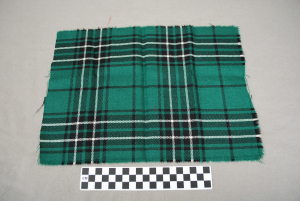This item is a piece of a Scottish tartan from the MacLean Clan, which is one of the oldest clans in the Scottish Highlands. It consists of green, white, and black patterned lines. Tartans have a long history, not just in Scotland but around the world, where the familiar plaid pattern has been used for centuries. Today we view the tartan pattern as representative of Scotland and their kilts.
Tartans are the patterns of interlocking different colored stripes that run horizontally and vertically, which are known as the warp and weft of the cloth. Tartans are defined as the pattern itself, so it can technically be used to describe the pattern in any form, such as in a digital picture, painting, or print. The earliest tartans can be dated back to the third or fourth century A.D. in Scotland though the pattern can be found as early as 3000 B.C. in other parts of the world. Originally tartan patterns did not have any significance, it was not until the 17th and 18th centuries that tartan began to symbolize clan affiliation.
The naming of tartan patterns began after 1765 when the firm William Wilson & Sons of Bannockburn began producing and collecting tartan patterns. By 1815 100 tartans had been named and clan chiefs began to gain interest in preserving their history and identifying a pattern that represented their clan. In 1822, King George IV visited Scotland expecting to see the clans present their tartans, this forced many clan leaders to choose or invent new tartans for their clan. Although tartans today are generally thought to represent clans, they can also represent towns, districts, corporations, individuals, and events.
This tartan is connected to the MacLean Clan of Duart Castle. Today the MacLean Clan has more than 10 different tartan patterns registered with the Scottish Register of Tartans. The MacLean’s have the prestige of having one of the oldest recorded tartans, which was described as early as 1587. Although it is difficult to know the exact origins of the clan, clan historians trace their ancestors as far back as 1050. Their name itself originated in 13th century when Gilleain na Tuaighe was chief. Maclean literally translates to son of Gilleain.
Today, tartans continue to be made and in the last fifty years have become an increasingly profitable business dominated by a few large mills. The tartan continues to be a representation of Scotland as much as kilts and bagpipes are. People continue to connect their genealogical history to their ancestral clans and the corresponding tartans. Clans continue to meet in reunions in Scotland, and Highland Games around the world to this day.
